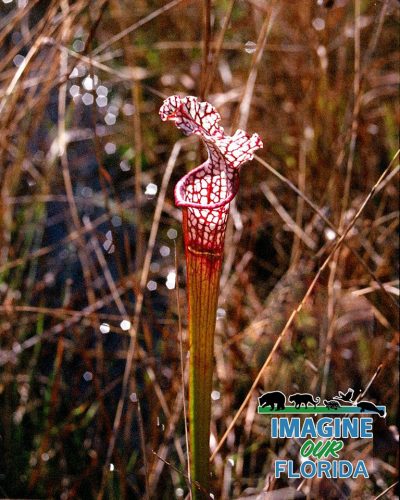WHITE-TOP PITCHER PLANT Sarracenia leucophylla
Florida has more carnivorous plants than any other state. They are mostly found in the panhandle but can be found in bogs as far south as central Florida. Their roots are mostly used to hold the plant in place. Many of the carnivorous plants reproduce by flowering and producing seeds. Some of these plants produce beautiful and showy blooms to attract pollinators.
The carnivorous plants that make Florida their home are not your typical potted Venus flytrap yelling, “Feed Me, Seymour.”. These plants fill Florida’s sandy, wet plains, and bogs. The soil in which carnivorous plants are found tends to be poor in nitrogen due to the wet environment. The nitrogen washes away before the plant can absorb it but these plants have adapted. Using several methods, carnivorous plants are able to trap the bugs and small mammals they need for this vital nutrient.
The whitetop pitcher plant, also known as the Swamp Lily, is endangered. Its habitat consists of mixed-grass wet prairies, wet flatwoods, seepage slopes, streamside seeps, and wet prairie ecotones of dome swamps and depression marshes. Flowering time is from March to May.
Insects are attracted to the pitcher plant’s sweet nectar which is secreted by its leaves. Once on top of the pitcher, the insect slips on the waxy opening and falls into the plant where fine hairs prevent it from escaping. Enzymes will produce a digested insect which provides the pitcher plant with much-needed nitrogen.
Carnivorous Plants are sentinels of the general condition of their environment. One of the first things to go when wetlands degrade is its carnivorous plants.
Threats to pitcher plants include fire suppression, disrupted hydrology, feral hogs, and poaching of the plants.
Learning about Florida’s carnivorous plants may transform you into a naturalist!
Photo Credit – Andy Waldo

